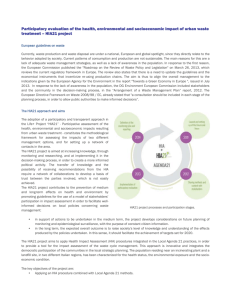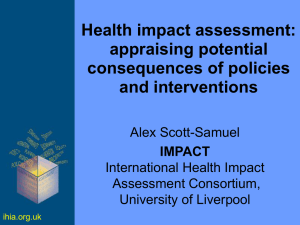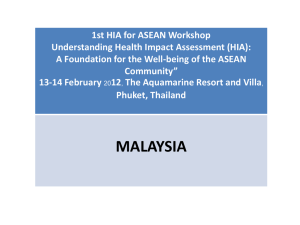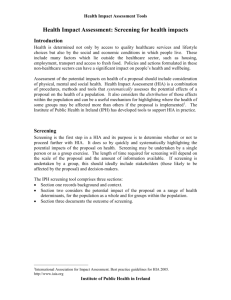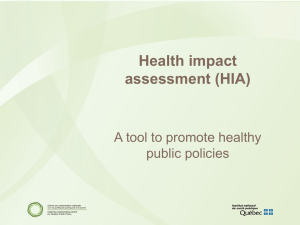HIA Training July 16, 2014 - Minnesota Department of Health
advertisement
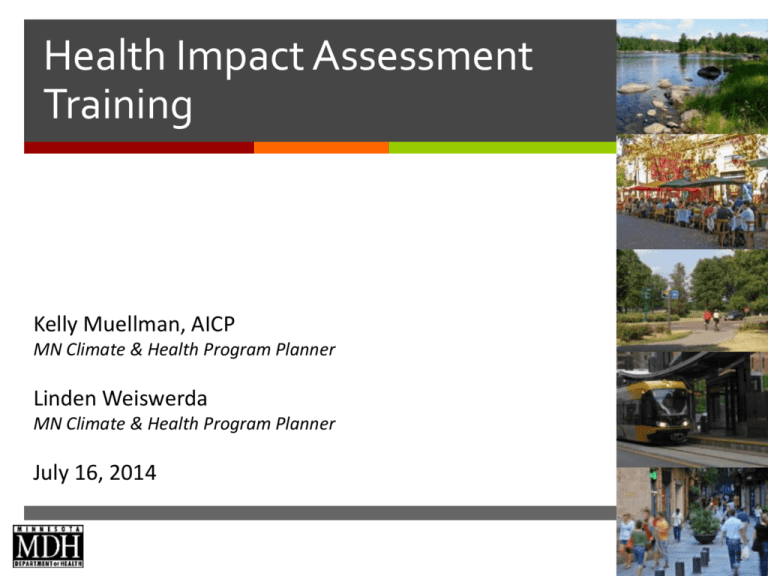
Health Impact Assessment Training Kelly Muellman, AICP MN Climate & Health Program Planner Linden Weiswerda MN Climate & Health Program Planner July 16, 2014 1 Acknowledgements This HIA training is supported by a grant from the Health Impact Project, a collaboration of the Robert Wood Johnson Foundation and The Pew Charitable Trusts. The opinions expressed are those of the author(s) and do not necessarily reflect the views of the Health Impact Project, Robert Wood Johnson Foundation or The Pew Charitable Trusts. 2 Agenda Welcome & Introductions Connections between health and the environment Introduction to HIA Step 1: Screening Step 2: Scoping Step 3: Assessment Step 4: Recommendations Step 5: Reporting Step 6: Evaluation and Monitoring Training Evaluation 3 Today Think . . . Slide 1 Slide 1 Complete Street’s Photostream - Flickr Slide 2 Slide 2 ©Ann Forsyth. Used with permission. Slide 3 Slide 3 Source: Wikipedia.org Slide 4 Slide 4 Source: Raise the Wage MN Learning Objectives The purpose of an HIA: to provide health information to decision-makers before important decisions are made, so they can make a more informed decision Six HIA steps and HIA process 9 What is health? Health is a state of complete physical, mental and social well-being and not merely the absence of disease or infirmity. Source: World Health Organization This definition has not been amended since 1948 Something is wrong 2010 Avg Life Expectancy and Healthcare Spending US ranked 42nd in life expectancy for 2010 and 1st in health spending per capita. WHO and Global Health Expenditure Database http://www.gapminder.org/ Health Determinants Health status is determined by: 30% by genetics; only 10% by health care; but 60% by social & environmental conditions, and behavior Source: N Engl J Med 2007;357:1221-8. 12 What do Minnesotans die from? Leading causes of death in Minnesota: 2010 Cause Deaths 1. Cancer 9,599 2. Heart Disease 7,144 3. Unintentional Injury 2,087 4. Stroke 2,154 5. Chronic Lower Respiratory Disease 2,012 Rate 166.9 118.7 36.4 35.8 35.1 Health Impact Assessment (HIA) Definition: A systematic process that uses an array of data sources and analytic methods and considers input from stakeholders to determine the potential effects of a proposed policy, plan, program, or project on the health of a population and the distribution of those effects within the population. HIA provides recommendations on monitoring and managing those effects. National Research Council, Improving Health in the United States: The Role of Health Impact Assessment, 2011. 14 Why Conduct HIA? Identify harms and benefits before decisions are made Identify evidence-based strategies and recommendations to promote health and prevent disease Increase transparency in the policy decision-making process Support inclusive and democratic decision-making Support community engagement in the decision-making process Advance equity and justice Shift decision-making from an economic to a quality of life framework Inform a discussion of trade-offs involved with a project or policy Facilitate decisions and their implementation 15 Values of Health Impact Assessment HIA aims to advance the values of democracy equity sustainable development the ethical use of evidence a comprehensive approach Source: http://www.policylink.org/atf/cf/%7B97c6d565-bb43-406da6d5-eca3bbf35af0%7D/PROMOTINGEQUITYHIA_FINAL.PDF to health North American HIA Practice Standards Working Group (Bhatia R, Branscomb J, Farhang L, Lee M, Orenstein M, Richardson M). Minimum Elements and Practice Standards for Health Impact Assessment, Version 2. North American HIA Practice Standards Working Group. Oakland, CA: 16 November 2010. Types of Decisions Influenced by HIA • Policy Decisions (bills by state legislature, city council decision, local school board on district-wide policy) • Policy Implementation (weigh various implementation options for a policy once it is passed) • Project Specific (siting, permitting, construction, design) • Comprehensive Plans (neighborhood plan, regional growth plans, master planning documents) Provided by Health Impact Project http://www.healthimpactproject.org/ 17 What topics have HIAs addressed? Provided by Health Impact Project http://www.healthimpactproject.org/ 18 HIA in the U.S. 314 HIAs (5/28/2014) Source: Health Impact Project http://www.healthimpactproject.org/ 19 HIA at the National Level Two major national funders Centers for Disease Control & Prevention (CDC) (directly funds grantees; ASTHO-HIAs, training, TA) Health Impact Project (PEW and RWJF) SOPHIA (Society of Practitioners of HIA): http://www.hiasociety.org/ Two conferences: HIA of the Americas Workshop (Oakland, CA) National Health Impact Assessment Meeting (Washington DC) 20 HIA Minimum Elements & Practice Standards Minimum elements to include in every HIA Guidance for each step of HIA Also, guidance and training available at Human Impact Partners (HIP) www.humanimpact.org/ 21 HIA in Minnesota 2006-2014: 21 HIAs completed or in-progress MN HIA Coalition Training Technical Assistance MDH website/listserv Funding (BCBS Foundation of Minnesota) http://www.health.state.mn.us/divs/hia/ 22 Duluth’s HIA: th 6 Ave E Redesign • Schematic Redesign Study on the former MN Trunk Hwy 194 completed in January 2011 • Straight, four-lane, high speeds, main arterial • Barrier for all non-motorized transportation/school access • Local HIA Team: PH educator, engineer, city planner, GIS specialist • MDH technical assistance Duluth’s HIA: 6th Ave E Redesign (cont.) Built off of existing partnerships Used public meetings for input Duluth’s HIA: Accessibility & Safety Physical Activity Livability Pollution Food Access HIA becomes an addendum to the Sixth Avenue East Schematic Redesign Study 24 Gary/New Duluth Small Area Plan Small Area Plan components: Commercial & Residential development Natural Environment Transportation Parks HIA focus areas: Social cohesion Physical activity Access to healthy food 25 Gary/New Duluth: Stakeholder Engagement Technical Advisory Committee Community survey Paper (distributed widely) Online (Survey Monkey) Public meetings 26 Lincoln Park Small Area Plan Kicked-off in May 2014 Integrated process “Health in all policies” Building upon existing studies & initiatives: OneRoof 2012 NRP Duluth-LISC Ecolibrium3 On the Move Lincoln Park 27 Six Steps of HIA 1. Screening - to determine if an HIA is useful for a specific project or policy 2. Scoping - identify which health effects to consider 3. Assessment - determine which people may be affected and how they may be affected 4. Recommendations - suggest changes to proposal to promote positive or mitigate adverse health effects 5. Reporting - present the results to decision-makers 6. Evaluation and Monitoring - determine the affect of the HIA on the decision process 28 Step 1: Screening 29 Step 1: Screening: What is HIA Screening? The Screening process helps determine if: … the HIA is feasible Is there sufficient information about the decision? Is there available resources to conduct the HIA? … the HIA can be done in a timely manner Can the HIA fit within the decision-making time frame? … the HIA would add value to the decision making process Is health already at the table? Will the proposed project benefit from an HIA and promote health and influence positive change to the community? 30 Types of HIAs Upstream Public Health, Portland, OR Modified from Harris et al, 2007, Health impact assessment: A practical guide, Centre for Health Equity, Training, Research and Evaluation (CHETRE), Part of the UNSW Research Centre for Primary Health Care and Equity, UNSW http://www.hiaconnect.edu.au/hia_a_practical_guide.htm 31 Screening: When not to do an HIA No added value Chula Vista Plan to Improve Walkability Plan was already considering health Health advocates involved in design Resources better focused elsewhere No influence on decision Milwaukee Zoo Interchange Project Time: insufficient time to complete HIA for drafts Stakeholders: DOT was not open to considering health (recommendations seen as another obstacle or more red tape) Source: Wisconsin Department of Health Services, Health Impact Assessment: A Tool to Increase Health Equity in Decision-Making, Great Lakes Intertribal Council, April 23, 2012 32 Concerns about HIA Concern Response HIA is costly Not as costly as treatment of health impacts in the long run HIA is time-consuming and will slow decision-making process Conducting the HIA early will bring issues to the front of the decision-making process, potentially speeding approval processes, and preventing costly litigation that delays projects HIA will stop economic development The role of HIA is to identify mitigations and recommendations, not to say “don’t do that” HIA is not scientific Role of HIA is to pull together disparate pieces of the best available evidence to make a broad statement about impacts Source: Wisconsin Department of Health Services, Health Impact Assessment: A Tool to Increase Health Equity in Decision-Making, Great Lakes Intertribal Council, April 23, 2012 33 HIA Screening: Getting Started How to start the screening process: 1. Define the decision What is being proposed? What is the timeline for the decision? Project Launch Final Decision Draft Plan Available Can the HIA be ready here? 34 HIA Screening: Engaging Stakeholders 2. Decide who will be involved in the screening process Identify the stakeholders (i.e., residents, business owners, regional agencies, local organizations, elected officials) 3. Determine if potential partners are ready to work on the HIA Do they have the resources available to conduct an HIA? 35 HIA Screening 4. Evaluate the program, plan, or policy based on screening criteria (including will the program have a significant impact on health) Utilize a Screening Worksheet or a Checklist There are a number of worksheets to choose from Use the worksheet that best meets your needs 36 Screening Criteria Has a project, plan or policy been proposed? Is there time to conduct HIA before decision is made? Will the project, plan or policy affect health? Would health inequities be impacts? How? Are health impacts likely to be significant in terms of number of people impacted (magnitude), severity of impact, or immediacy or permanence of impacts? Is there expertise, evidence and/or research methods available to analyze health impacts? 37 Screening Criteria (cont.) Is health already being considered? Are there clear links between the proposal and health? Are decision-makers open to considering HIA findings? Will the HIA process have potential health impacts? Do stakeholders have the interest and capacity/resources to participate in the HIA? 38 HIA Screening: Notify Stakeholders The Final & Essential Screening Task 1. Define the decision and its alternatives 2. Decide who will be involved in the screening process 3. Determine if potential partners area ready to work on the HIA 4. Evaluate the project plan, or policy based on screening criteria 5. Notify stakeholders of your decision Will you be conducting an HIA? 39 5 Minute Brainstorm Project, Plan or Policy that might benefit from an HIA 40 Step 2: Scoping 41 Step 2: Scoping: Two Main Goals Two Main Goals: 1. Create the plan for the HIA 2. Determine health indicators to be assessed Health issues that will be assessed 42 Scoping: Determine Responsibility Determine: Team responsible for conducting the HIA Group who will oversee the HIA process Stakeholder engagement 43 Scoping: Stakeholder Engagement In addition to promoting inclusive, healthy, and equitable communities, stakeholder participation can improve the efficacy of an HIA by helping to: identify important stakeholder concerns bring important reflections of experience, knowledge, and expertise ground truth findings and recommendations by ensuring that the lived reality matches priorities, data, and analysis support the value of equity and democracy within the HIA create more support for the implementation of HIA recommendations shape communication and dissemination methods 44 Who Are the Stakeholders? Who are the stakeholders? Public health agencies Community residents/ organizations Public agencies Policy makers Businesses Populations likely to be impacted by a decision should be involved and have an oversight role in the HIA process 45 Stakeholder Analysis Stakeholder Group (Description /Key Contact) Interest in HIA or related decision? Power to How and influence the when (what decision stage) to (high/ engage? medium/ low) Potential Barriers/ role in/ challenges to contribution engagement to HIA 46 How to Involve Stakeholders How should stakeholders and the affected communities be involved? Advisory Committee Public meetings Small group discussions/ Focus groups Comment forms Project website Workshops/ Design charrettes Surveys 47 Lincoln Park Small Area Plan/HIA Kick-off at Our Lincoln Park community event Community survey Monthly meetings with 30+ organizations Public meetings 48 Stakeholder Engagement: Challenges Developing and maintaining relationships Establishing common goals, expectations, ground rules Managing conflicting interests and perspectives Ensuring meaningful involvement that leads to empowerment Start-up is important! Scoping: Create the Plan for the HIA First meeting(s): Discuss HIA plan, timeline and the decision and alternatives Ground rules Goals of HIA & screening Communications plan Geographic area Population(s) and subpopulations to be studied 50 Scoping: Identifying Health Issues All possible health issues Scoping next meetings: Examine the range of possible health issues Come to agreement on priority health issues Discuss pathways Determine research questions, data sources & methods Health issues that will be assessed 51 Examine Range of Health Issues Concerns identified during stakeholder engagement Start baseline data investigation 52 Examine Range of Health Issues (cont.) Start baseline data investigation Census Tract 38 Duluth Minnesota Population below poverty level Population under 18 below poverty level 12.2% 21.4% 11.0% 7.3% 25.2% 14.0% Population 65 years and over below poverty level 14.4% 8.5% 8.3% 53 Scoping: Determine Health Indicators Come to agreement on priority health issues Prioritization Criteria Health impacts with the greatest potential significance, magnitude, severity, certainty, permanence Stakeholder/community priorities Equity Available resources: time, existing data/research, ability to collect new data for gaps in data/research 54 Gary/New Duluth Scoping meeting: Discussed existing conditions in neighborhood Discussed input from community survey Voted Scoped 3 Health Determinants: 1. Social Capital 2. Physical Activity 3. Access to Healthy Food Health Determinant Votes social capital 5 physical activity 3 access to healthy food 3 stress or mental health 2 crime 2 jobs 2 community livability/ living conditions 2 gentrification/ displacement quality of life 1 1 55 Scoping: Pathways & Research Questions All possible health issues Scoping next meetings: Examine the range of possible health issues Come to agreement on priority health issues Discuss pathways Determine research questions, data sources & methods Health issues that will be assessed 56 Scoping - Pathways Pathways can be direct: Traffic and vehicle speeds Motor vehicle accidents Injuries and deaths Or indirect: New business Employment opportunities Ability to meet basic needs Food security and can be fairly complicated… 57 Scoping – Pathways (example 1) Source: Oregon Farm to School and School Garden Policy, HB 2800 Health Impact Assessment 58 Scoping – Pathways (example 2) Source: Healthy Corridors for All HIA 59 Pathway Exercise Proposed Changes Short Term Outcomes Intermediate Outcomes Health Outcomes Proposed change 60 Pathway Diagrams: Summary A visual tool for explaining what the HIA will study Help generate research questions Help stakeholders and decision-makers understand potential effects of decision making, and their relative importance Can show how changes to a proposal or other conditions may lead to changes in health outcomes Identify where there is uncertainty about causes andeffects or magnitude of impacts Help guide the selection of recommendations Developing Research Questions Create a plan for the Assessment: Focus your research Create research questions Baseline questions versus Impact questions Too generic: Is pedestrian safety an issue? Ho will the proposed plan affect pedestrian safety? Better: How many pedestrian, bicyclist, and motor-vehicle accidents are there today and at what locations? How will the proposed changes to policy, programming, and projects affect the number and/or rate and location of accidents? 62 HIA Scoping Worksheet Project: Health Determinant: Geographic Scope: Existing Conditions Research Questions How many pedestrian, bicyclist, and motor-vehicle accidents are there today? How does Winona County compare to the state? Are there “problem areas” with higher number or rates of accidents? Winona County Active Living Plan HIA Traffic & pedestrian safety County Impact Research Questions How will the proposed changes to policy, programming, and projects affect the number and/or rate of accidents? How will the proposed changes to policy, programming, and projects affect the location, number and/or rate of accidents? Indicators Methods Priority Notes Data Source Motor vehicle, pedestrian and bicyclist crashes (by date, location, and cause – Do they also have age?) Injuries (ED visits and hospitalizations) and mortality from accidents Motor vehicle, pedestrian and bicyclist crashes (by date, location, and cause – Do they also have age?) 63 HIA Scoping Exercise Project: Health Determinant: Geographic Scope: Existing Impact Conditions Research Research Questions Questions Indicators Data Sources Methods Priority Notes 64 Purpose and Use of Scoping Worksheet Scoping Worksheet Identify research questions, data sources, and analytic methods for analysis Help identify where secondary data may exist and primary data collection is needed Identify participant roles and responsibilities for data collections Help guide discussion of prioritization for research questions and indicators 65 Scoping Outputs Scoping should result in a project plan for the HIA that includes: Pathways demonstrating how health could be affected by the proposed decision, and a summary of how issues were selected for inclusion Identification of the population and vulnerable groups that could be affected by the proposed decision Description of research questions, data sources, methods to be used, and any alternatives to be assessed Identification of data gaps Summary of how stakeholders were engaged in scoping, and how issues raised will be addressed in the HIA, or rationale for why not 66 Step 3: Assessment 67 Case Study 1 Healthy Corridor For All (MN) http://sapcc.org/node/600 68 Case Study 2 HB 2800: Farm to School and School Garden Policy (OR) Photos from: http://www.upstreampublichealth.org/sites/default/files/F2SHIA_FINAL.pdf 69 Six Steps of HIA: Step 3 1. Screening - determine if HIA is useful for specific project or policy 2. Scoping - identify health effects to consider 3. Assessment – perform research, determine populations affected & how 4. Recommendations - suggest changes to proposal to promote positive or mitigate adverse health effects 5. Reporting - present results to decision-makers 6. Monitoring and evaluating - determine effect of HIA on decision process 70 Step 3: Assessment: Main Goals Main goals: 1. Profile baseline conditions, characteristics of target populations 2. Analyze potential health effects of decisions 71 Build Off of Pathway Diagrams Policy Direct Impacts Rate of car ownership in population? Light Rail Construction ↓ car use Intermediate Impact Health Outcomes Measures of air pollutants in area of concern? ↓ GHG Emissions Rates of asthma? ↓ Asthma Baseline Profile U.S. Census Hospital-discharge records Disease registries Behavioral Risk Factor Surveillance Survey Traffic with 73 solo drivers vs. traffic with 73 commuters using bus, carpool and vanpool. 73 Baseline Profile: Data limitations Scale discrepancies Proxy measures 74 Ex: Healthy Corridor for All - Topics Healthy Corridor For All Health Economy Affordable, Healthy Housing Safe & Sustainable Transportation 75 Ex: Healthy Corridor for All – Data Selection Healthy Corridor For All Measurability Availability Time & Resources Ability to answer research questions, objectives Relevance 76 Ex: Healthy Corridor for All - Indicators Indicator Data Source Methodology Distribution of population by race/ethnicity US Census 1990, 2000, 2010 Aggregated total residents by race & ethnicity by block group for CC, St Paul, and Ramsey County (1990,2000); aggregated total residents by race & ethnicity by block for CC (2010) Number of US Census 2010; persons living Metro Transit within ¼ mile of transit lines Selected all high-frequency bus routes. Using ArcGIS, selected all blocks within ¼ mile. Aggregated total population residing in those blocks in SPSS for all blocks within the CC Location of bike St Paul, Dept of & ped collisions Public Works,‘03-07 Summed total number of bike and ped collisions in CC Small, minority- U-PLAN survey owned businesses Selected all businesses located in St Paul only; summed institutions identified as “small” and as “minority-owned” 77 Ex: Healthy Corridor for All – Students by Race 78 Ex: Healthy Corridor for All – Transit Dependence 79 Ex: Healthy Corridor for All – Community Assets 80 Ex: Farm to School – Research Questions HB 2800 Farm to School http://www.healthimpactproject.org/resources/document/Upstream-HIA-Oregon-Farm-to-School-policy.pdf 81 Ex: Farm to School – Statewide maps HB 2800 Farm to School Percent of Oregon population in poverty, 2009 http://www.healthimpactproject.org/resources/document/Upstream-HIA-Oregon-Farm-to-School-policy.pdf 82 Step 3: Assessment – Analyze potential health impacts Main goals: 1. Profile baseline conditions, characteristics of target populations 2. Analyze potential health effects of decisions 83 Analysis – Literature Review Literature Review 84 Analysis: Qualitative & Quantitative Data Qualitative Quantitative Behaviors, beliefs Statistics, models Focus groups, interviews, surveys, transcripts Census data, epidemiological studies, direct sampling, modeling 85 Analysis – Example methodology 86 Analysis: Healthy Corridor for All Healthy Corridor For All Mixed methods Qualitative: literature review, public meetings Quantitative: extensive use of existing data for summary statistics and predicting impacts 87 Analysis: Healthy Corridor for All (cont.) Healthy Corridor For All Increased pedestrian injury and/or fatalities due to unsafe intersections are likely UNSAFE INTERSECTIONS FOR PEDESTRIANS RELATIVE TO PROJECTED INCREASES IN HOUSING BY STATION AREA 88 Analysis: Farm to School HB 2800 Farm to School Mixed methods Qualitative: literature review, interviews, community forums Quantitative: secondary data analysis, economic procurement analysis (IMPLAN) Photos from: http://www.upstreampublichealth.org/sites/default/files/F2SHIA_FINAL.pdf 89 Analysis: Farm to School (cont.) HB 2800 Farm to School 90 Assessment In THEORY: In PRACTICE: Identify determinants Multiple interacting factors Complete baseline profile Assess potential impacts Estimate change in population health that could affect health Lack of data or empirical evidence Lack of consensus amongst stakeholders 91 Assessment - Summary You don’t have to predict everything with absolute certainty Look at all the evidence available and make an informed judgment based on analysis of data expertise experience Validity = Transparency 92 Exercise If you were going to do an HIA on …. What information or analysis would you need? Talk amongst your group. 93 HIA Scoping Worksheet (Part 2) Project: Health Determinant: Geographic Scope: Existing Impact Conditions Research Research Questions Questions Indicators Data Sources Methods Priority Notes 94 Step 4: Recommendations 95 Six Steps of HIA: Recommendations 1. Screening - determine if HIA is useful for specific project or policy 2. Scoping - identify health effects to consider 3. Assessment – perform research, determine populations affected & how 4. Recommendations - suggest changes to proposal to promote positive or mitigate adverse health effects 5. Reporting - present results to decision-makers 6. Monitoring and evaluating - determine effect of HIA on decision process 96 Recommendations Assessment work • Baseline profile • Lit Review • Impact analyses Stakeholder input • Decision leaders • Affected parties Recommendations • • • • Mitigate negatives Promote positives Offer alternatives Take a position 97 What makes a good HIA recommendation? Specific & immediately actionable Identifies lead organizations & roles in implementation Best practices or evidence-based Reflect scoping priorities and predicted impacts Measurable Feasible Economical 98 Recommendations: Specific & immediately actionable Bad: Increase commercial parking vs Good: Adopt regulations that would allow use of undeveloped parcels for temporary parking lots to relieve parking problems during light rail construction and in the near term. Temporary lots must meet standards to control impacts on local traffic and minimize aesthetic impacts (HCFA) 99 Recommendations: Identifies lead organizations & roles in implementation Bad: Increase efforts to market food products from Oregon vs Good: The OR State Department of Agriculture & the OR Department of Education should collaborate with the OR Agriculture Extension Service to help producers develop marketing materials that communicate a product’s “produced or processed in OR status”…& help school district buyers develop & use language in their Request for Proposals that specify an OR product preference (F2S) 100 Recommendations: Best practices or evidence-based Good: …recommendation regards use of Oregon food items in school meals. Much of Farm to School research is centered on salad bars, and they have been shown to increase the amounts of fruits and vegetables consumed by children…(F2S) Good: The proposed changes to the zoning ordinance would include…specific cross-references to adopted plans and policies to strengthen basis for regulation (e.g., Housing Plan 2010, Central Corridor Development Strategy, etc.). (HCFA) 101 Recommendations: Reflect scoping priorities and predicted impacts 102 Recommendations: Measurable Good: The First Source Hiring Program would require that all applicants notify the St. Paul Human Rights & Equal Economic Opportunities Department of available job openings. The contractor would be required to maintain a log of referrals to allow the program to monitor compliance. (HCFA) Good: Schools could identify & promote the Aggregated Nutrient Density Index (ANDI) scores for different salad bar items. ANDI scores incorporate a food item’s nutrient to calorie ratio; foods with higher ANDI scores are nutrient dense and calorie light. (F2S) 103 What makes a good HIA recommendation? (cont.) Feasible (technically & politically) Economical However… Measurable Feasible Economical Creative Controversial Bottom Line: Positive Health Impact & Community Supported 104 Recommendations Exercise Good HIA Recommendations are . . . Specific & immediately actionable Identifies lead organizations & roles in implementation Best practices or evidence-based Reflect scoping priorities and predicted impacts Measurable Feasible Economical 105 Step 5: Reporting 106 Step 5: Reporting - Objective Objective Develop HIA report and communicate findings and recommendations 107 Transparency in HIA Reporting Practice Standards call for the public release of an HIA and a transparent accounting of the process and findings Allows findings to be reviewed and improved Informs affected communities of possible health impacts Informs agencies of potential changes in demand for services (emergency response, etc.) Warns those potentially responsible for impacts Allows people to take voluntary actions to avoid risk 108 Reporting: Refer to Communication Plan Refer to HIA Communications Strategy or Plan Goals Audiences Objectives, Strategies, Tactics Key messages Spokespeople and messengers 109 Examples of HIA Reporting Formal report Letters to proponents and decision-makers Comment letters on or reports included in draft EIS Public testimony Presentations Peer-reviewed publications Website Source: Human Impact Partners. HIA General Training Slides. August 27, 2012. http://www.humanimpact.org/hia-training 110 Reporting: Writing the Report Essential Tasks: Determine format and structure Write the report Offer opportunity for meaningful feedback on report Update report or address substantive criticism through a formal written response Implement communications plan 111 Example: Reporting - Communications Bottineau HIA Released draft HIA report Published summary in 5 languages: English, Hmong, Laotian, Somali, and Spanish Advertised 2 month public comment period (July 15 – Sept 15) Incorporated feedback from stakeholders and the public into final HIA report (Releases December) 112 Reporting Exercise Who are you trying to reach? How would you reach them? (creative venues/media?) 113 Step 6: Evaluation & Monitoring 114 Step 6: Evaluation & Monitoring: Evaluation Evaluate: The process of conducting the HIA Impacts on the decision-making process and implementation of the decision Impacts of the decision on health outcomes 115 Evaluation: Process Evaluation Process evaluation—seeks to understand how the HIA was conducted Process evaluation of the HIA: What were the successes? What were the challenges? What worked? Who should we include next time? What data sources will you need in the future? Did the HIA meet the HIA minimum standards? Report on evaluation so that new HIA practitioners can learn from your successes and challenges 116 Process Evaluation from GND HIA Performed a self-evaluation. Answered key questions: Level of knowledge of HIA before & after project? What did you learn? What benefits did you gain? Was HIA an effective tool? How satisfied were you with the process and what would you change? What were/are the challenges or barriers? How has health data been useful in the process? Was the process inclusive and/or transparent? 117 Example Evaluation: GND HIA Level of knowledge of HIA (1 – 5): Before: 1.8 After: 3.3 Effectiveness of HIA as a tool: Overall responses were positive Effective depending on the implementation of SAP Changes: HIA training/instruction at the beginning of the process More frequent, longer meetings Timing: Do HIA between planning and implementation 118 to inform implementation of specific strategies Example Evaluation: GND HIA (cont.) Barriers/Challenges: Ensuring community participation and the difficulties getting the right people engaged in the process Concerns that staff wouldn’t know how to implement the HIA recommendations Ensuring that the HIA does not become “a series of familiar platitudes that look good on paper” Inclusiveness/ Transparency of Process: Transparency good Process should have included more of the affected populations 119 Impact Evaluation Impact evaluation seeks to understand the impact of the HIA itself on the decision and the decisionmaking process It typically looks at: Impact on the decision Impact the decision-making process New collaborations Increasing awareness of previously unrecognized health impacts 120 Outcome Evaluation Impacts of the decision on health outcomes Changes in exposures Health outcomes/determinants Unexpected consequences Difficult or impossible to evaluate the wide variety of factors that impact health outcomes the inability to accurately track what factors may have influenced a particular health outcome the length of time from implementation of a decision to observable changes in health indicators the lack of suitable comparison groups 121 Monitoring 4. Adjust Recommendations 1. Develop Recommendations 3. Monitor Recommendations 2. Implement Recommendations 122 Indicator Agency Responsible for Monitoring Timing Commercial Development - Improvement in the business climate/cooperation and increase in the number of businesses. City Planning, DEDA, GND Community Club, Visit Duluth/Parks & Recreation (wayfinding) Residential Development – Process developed to welcome new residents to the community and a focus on people with disabilities / senior care Natural Environmental – Plan developed for enhancing planting of trees, development of the GND Recreation Area and energy efficiency. GND Community Club, City Planning, DEDA 2016; Varies dependent on objectives noted in the HIA to improve the business environment. First quarter 2015 Social cohesion Transportation – Completion of condition survey of sidewalk/street/trails condition Trigger threshold Health Monitoring Plan City Planning, GND First quarter 2015 Development Alliance, GND Business Association City Planning, GND Community Club, MIC, MnDOT Park Planning – Starting capital GND Development improvements all the way to completion of Alliance, Parks & the GND Community Center and Recreation Recreation Area. 2015-2017 First quarter 2015 Establishment of GND Business Association. Establishment of a “welcoming” process. Commencement of capital improvements at the GND Recreation Area. Survey completed with action plan. Commencement of capital improvements at the GND 123 Recreation Area. Final Words about Evaluation Some see evaluation as a separate process—objectivity, funding, timeframe Lack of attention to evaluation is a barrier that will need to be overcome if HIA practice is to be advanced in the US 124 Review: HIA Steps 1. Screening - to determine if an HIA is useful for a specific project or policy 2. Scoping - identify which health effects to consider 3. Assessment - determine which people may be affected and how they may be affected 4. Recommendations - suggest changes to proposal to promote positive or mitigate adverse health effects 5. Reporting - present the results to decision-makers 6. Evaluation and Monitoring - determine the affect of the HIA on the decision process 125 HIA Reports Improving Health in the United States: The Role of Health Impact Assessment (http://www.nap.edu/catalog.php?record_id=13229) Minimum Elements and Practice Standards for Health Impact Assessment (http://www.humanimpact.org/doc-lib/finish/11/9) Guidance and Best Practices for Stakeholder Participation in Health Impact Assessments (http://www.hiasociety.org/documents/guide-forstakeholder-participation.pdf) Promoting Equity through the Practice of Health Impact Assessment: (http://www.policylink.org/atf/cf/%7B97c6d565-bb43406d-a6d5eca3bbf35af0%7D/PROMOTINGEQUITYHIA_FINAL.PDF) 126 Resources: HIA Websites MDH HIA webpage (http://www.health.state.mn.us/divs/hia/) CDC Healthy Places webpage (http://www.cdc.gov/healthyplaces/hia.htm) World Health Organization HIA webpage (http://www.who.int/hia/en/) HIA Gateway – Public Health England (http://www.apho.org.uk/default.aspx?QN=P_HIA) UCLA – HIA Guide web (http://www.hiaguide.org/) Health Impact Project website (http://www.healthimpactproject.org/) Design for Health website (http://www.designforhealth.net/resources/healthi mpact.html) Healthy Development Measurement Tool website (http://www.thehdmt.org/) Source: http://www.policylink.org/atf/cf/%7B97c6d565bb43-406d-a6d5eca3bbf35af0%7D/PROMOTINGEQUITYHIA_FINAL.P DF 127 Evaluation Please fill out the evaluation form! 128 Thank you!!! Kelly Muellman kelly.muellman@state.mn.us 651-201-5637 Linden Weiswerda linden.weiswerda@state.mn.us 651-201-4924 http://www.health.state.mn.us/divs/hia/ http://www.health.state.mn.us/divs/climatechange/ 129



